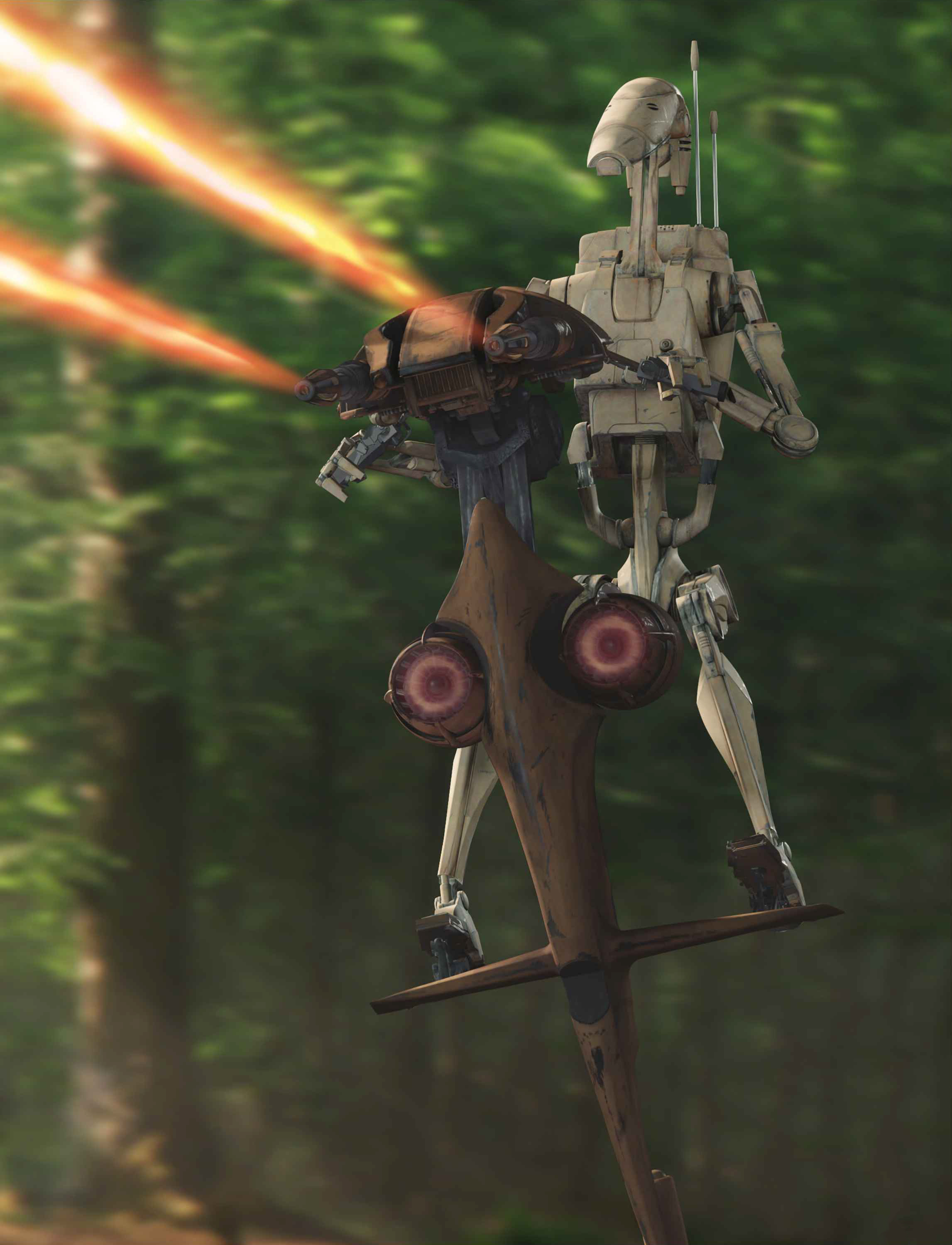The Single Trooper Aerial Platform (STAP-1 or STAP) was an agile flying machine designed for use by the Trade Federation's and Confederacy of Independent Systems' B1-Series battle droids.

A STAP firing its twin blaster cannons
Single Trooper Aerial Platforms were similar in design to personal repulsorlift airhooks used for both civilian and military purposes. Designed to travel fast, the STAP's only weapon was a twin blaster cannon connected to it. High voltage energy cells powered the machine.
Each STAP was piloted by a single B1-Series battle droid that stood on a long foot panel, gripping a pair of handles that controlled its weapons and were used to pilot the craft. B1 battle droids usually piloted these STAPs. STAPs utilized by the Trade Federation prior to the Clone Wars tended to be brown in color; Separatist STAPs were predominantly blue with white triangular markings.
The STAP-1 was used for scouting and anti-personnel hunting operations, and would occasionally be used in open battle to harass enemy forces. Because of its open design, STAP units were vulnerable to enemy heavy weapons, making them rely on their speed and agility to dodge enemy fire.
There was also a heavy STAP with larger laser cannons and a missile launcher.
It was the counterpart to the Republic 74-Z speeder bike.
Single Trooper Aerial Platforms were used over 3600 years before the Battle of Yavin by the forces of the Galactic Republic and the reconstituted Sith Empire.
STAPs were used extensively during the Invasion of Naboo in 32 BBY, where Trade Federation forces used them to great effect against the Naboo security teams and to subjugate the local populace.
Additional units were created at mech factories at the order of OOM-9.

A STAP in the color scheme of the Confederacy of Independent Systems
Later, they would be used during the Clone Wars, especially during the Dark Reaper crisis, on planets such as Raxus Prime, alongside heavy armored vehicles. During the Battle of Teth, STAPs were utilized by the Separatist forces against the clone troopers and AT-TEs scaling the cliff wall. Anakin Skywalker managed to destroy all but one by knocking their droid pilots off, using the remaining STAP to reach the top of the cliff. STAPs were again utilized by the Separatists on Naboo during the Blue Shadow Virus crisis. A small force of three battle droids riding STAPs were escorting a tactical droid when the convoy was destroyed by Captain Typho, Chrin and another member of the Royal Naboo Security Forces. They were also deployed by the CIS during the Battle of Tirahnn.
It later saw use during the Galactic Civil War when a small Jawa warlord named Wittin found a STAP and remote controlled B1 battle droid pilot. He then outfitted it with several modifications, such as a twin ion cannon to stop other vehicles as well as advanced armor upgrades. He then used this vehicle in Jabba Desilijic Tiure's dangerous gladitorial game.
An early form of the STAP dates back to the very first story treatment written by George Lucas in May of 1973. In it, the heroes travel through a dense jungle planet on "jet-sticks." This idea would go unexplored for over two decades before resurfacing in the revised rough draft of Episode I. In this version, the battle droids are said to ride STAPS, or Single Troop Armed Pogo Sticks. In developing the look of the STAP, Design Director Doug Chiang experimented with heavier versions of the vehicle, which appeared more like the speeder bikes from Return of the Jedi. Ultimately, he borrowed the lightweight design of a hummingbird to establish the STAP's final look.

STAPs were first seen in Episode I The Phantom Menace.
LEGO produced many sets including the STAP. The first set that included the vehicle was "7121 Naboo Swamp" based on a scene in The Phantom Menace. The second was in the set "7654 Droids Battle Pack" which featured a redesign of the first STAP. The third was from the set "7675 AT-TE Walker" which was based on the scene during the Battle of Teth. The fourth was the promotional UK set "30004 Battle Droid on STAP", in which the design's basis was from the third, and the fifth is in the 2011 set "7868 Mace Windu's Jedi Starfighter" which includes the third's design for the STAP.
Some sources released around the time of Star Wars: Episode I The Phantom Menace said that organic beings could not use STAPs due to the radiation from the thrusters at leg-level, but this has apparently been retconned with several sources since presenting organics using STAPs with no adverse effects.
In the 2001 video game Star Wars: Galactic Battlegrounds and its 2002 expansion pack, STAPs serve as the "strike mech" unit for the Trade Federation. Players are provided them in several missions of the campaign, and more may be built at mech factories for 50 units of food and 100 units of carbon.
Also, in the Star Wars MMO, Star Wars: The Old Republic, both the digital deluxe and The Collector's Edition would feature the Longspur STAP.
- LEGO Star Wars: The Video Game
- LEGO Star Wars: The Complete Saga
- LEGO Star Wars III: The Clone Wars
- Star Wars: Yoda's Challenge Activity Center